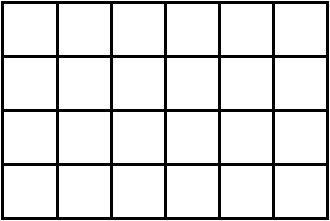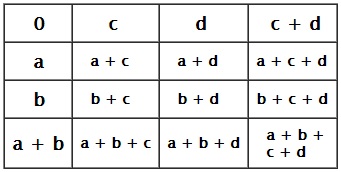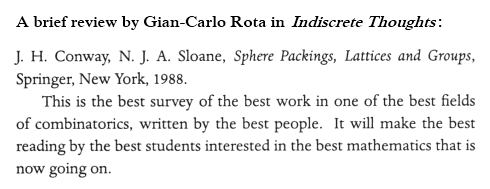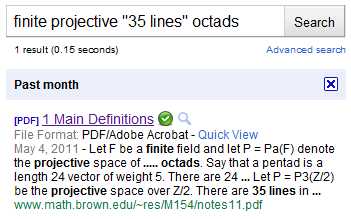The lexicographic Golay code
contains, embedded within it,
the Miracle Octad Generator.
By Steven H. Cullinane, July 13, 2020
Background —

The Miracle Octad Generator (MOG)
of R. T. Curtis (Conway-Sloane version) —

A basis for the Golay code, excerpted from a version of
the code generated in lexicographic order, in
"Constructing the Extended Binary Golay Code"
Ben Adlam
Harvard University
August 9, 2011:
000000000000000011111111
000000000000111100001111
000000000011001100110011
000000000101010101010101
000000001001011001101001
000000110000001101010110
000001010000010101100011
000010010000011000111010
000100010001000101111000
001000010001001000011101
010000010001010001001110
100000010001011100100100
Below, each vector above has been reordered within
a 4×6 array, by Steven H. Cullinane, to form twelve
independent Miracle Octad Generator vectors
(as in the Conway-Sloane SPLAG version above, in
which Curtis's earlier heavy bricks are reflected in
their vertical axes) —
01 02 03 04 05 . . . 20 21 22 23 24 -->
01 05 09 13 17 21
02 06 10 14 18 22
03 07 11 15 19 23
04 08 12 16 20 24
0000 0000 0000 0000 1111 1111 -->
0000 11
0000 11
0000 11
0000 11 as in the MOG.
0000 0000 0000 1111 0000 1111 -->
0001 01
0001 01
0001 01
0001 01 as in the MOG.
0000 0000 0011 0011 0011 0011 -->
0000 00
0000 00
0011 11
0011 11 as in the MOG.
0000 0000 0101 0101 0101 0101 -->
0000 00
0011 11
0000 00
0011 11 as in the MOG.
0000 0000 1001 0110 0110 1001 -->
0010 01
0001 10
0001 10
0010 01 as in the MOG.
0000 0011 0000 0011 0101 0110 -->
0000 00
0000 11
0101 01
0101 10 as in the MOG.
0000 0101 0000 0101 0110 0011 -->
0000 00
0101 10
0000 11
0101 01 as in the MOG.
0000 1001 0000 0110 0011 1010 -->
0100 01
0001 00
0001 11
0100 10 as in the MOG.
0001 0001 0001 0001 0111 1000 -->
0000 01
0000 10
0000 10
1111 10 as in the MOG.
0010 0001 0001 0010 0001 1101 -->
0000 01
0000 01
1001 00
0110 11 as in the MOG.
0100 0001 0001 0100 0100 1110 -->
0000 01
1001 11
0000 01
0110 00 as in the MOG.
1000 0001 0001 0111 0010 0100 -->
10 00 00
00 01 01
00 01 10
01 11 00 as in the MOG (heavy brick at center).
Update at 7:41 PM ET the same day —
A check of SPLAG shows that the above result is not new:

And at 7:59 PM ET the same day —
Conway seems to be saying that at some unspecified point in the past,
M.J.T. Guy, examining the lexicographic Golay code, found (as I just did)
that weight-8 lexicographic Golay codewords, when arranged naturally
in 4×6 arrays, yield certain intriguing visual patterns. If the MOG existed
at the time of his discovery, he would have identified these patterns as
those of the MOG. (Lexicographic codes have apparently been
known since 1960, the MOG since the early 1970s.)
* Addendum at 4 AM ET the next day —
See also Logline (Walpurgisnacht 2013).












.gif)








































